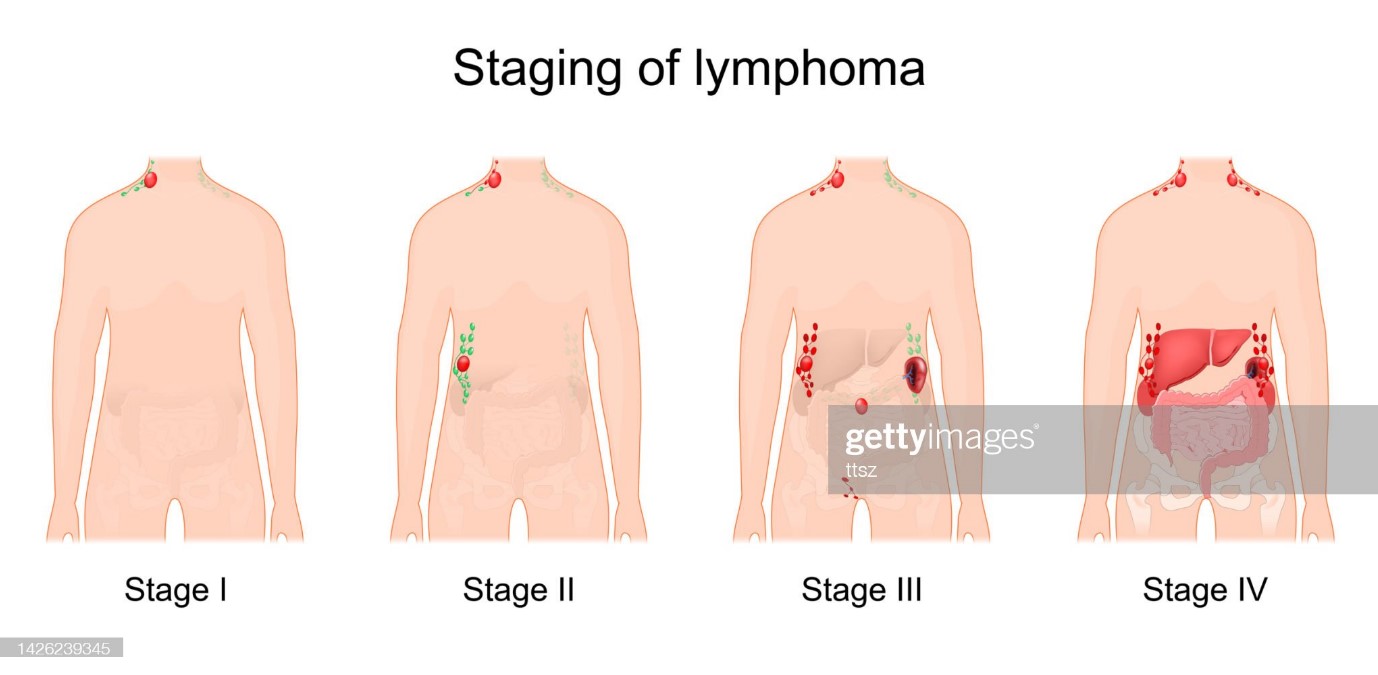What is Hodgkin's Lymphoma?
What is Hodgkin's Lymphoma?Lymphoma is a cancer that starts in white blood cells called lymphocytes. There are two types of lymphoma: Hodgkin’s lymphoma and non-Hodgkin’s lymphoma.
Hodgkin’s lymphoma is a type of cancer that develops in the lymph system (also called the lymphatic system). The lymph system is part of the immune system, which helps protect the body from infection and disease.
There are two types of lymphocytes in the lymph system, lymphocytes and T lymphocytes. In Hodgkin’s lymphoma, lymphocytes start to change and multiply, often in lymph nodes in the upper part of the body, but it can start in other parts of the lymph system.
The reason for the B lymphocytes’ change (mutation) is not known. The affected B lymphocytes continue to multiply without control and may spread through the lymph vessels to other lymph nodes, where they continue to multiply. These changes lower your ability to fight infection.
Stages of Hodgkin's Lymphoma
StagesCancer staging describes the extent of cancer at the time of diagnosis. The staging system used for Hodgkin’s lymphoma is called the Lugano classification. It has four stages: I, II, III, and IV.
- Stage I. Hodgkin’s lymphoma is stage I if:
- Cancer is found in only one lymph node area or lymphoid organ such as the spleen (stage I) or
- The cancer is found only in one part of an organ that is outside the lymph system (stage IE).
- Stage II. Hodgkin’s lymphoma is stage II if:
- Cancer is found in two or more lymph node areas, either both above or both below the diaphragm (stage II) or
- The cancer extends locally from one lymph node area into a nearby organ (stage IIE).
- Stage III. Hodgkin’s lymphoma is stage III if:
- Cancer is found in lymph node areas above and below the diaphragm or
- Cancer is found in lymph nodes above the diaphragm and in the spleen.
- Stage IV. Hodgkin’s lymphoma is stage IV if the cancer has spread into at least one organ outside of the lymph system, such as the liver or the lungs.

“Resistant” or “recurrent” Hodgkin’s lymphoma are additional terms that your care team may use to describe the lymphoma:
- Resistant disease refers to lymphoma that does not respond to treatment or progresses and grows while you are in treatment.
- Recurrent or relapsed disease refers to Hodgkin’s lymphoma that responded to treatment but later comes back. When the lymphoma returns, it may be in the same place that it started or in another part of the body. This can happen shortly after treatment or years later.
Types of Hodgkin's Lymphoma
TypesThe two main types of Hodgkin’s lymphoma are classic Hodgkin’s lymphoma and nodular lymphocyte-predominant Hodgkin’s lymphoma. Treatment for the two types of Hodgkin’s lymphomas is often different.
- Classic Hodgkin’s lymphoma is the more common type. The classic type includes the following four subtypes:
- Nodular sclerosing Hodgkin’s lymphoma
- Mixed cellularity Hodgkin’s lymphoma
- Lymphocyte-depleted Hodgkin’s lymphoma
- Lymphocyte-rich classic Hodgkin’s lymphoma
- Nodular lymphocyte-predominant Hodgkin’s lymphoma is rare and typically develops slower than classic Hodgkin’s lymphoma.
Symptoms & Signs of Hodgkin’s Lymphoma
SymptomsThe signs and symptoms of Hodgkin’s lymphoma may include:
- Painless, swollen lymph nodes in the neck, underarm, or groin
- Fever for no known reason
- Drenching night sweats (heavy sweating during sleep)
- Weight loss for no known reason in the past six months
- Itchy skin, especially after bathing or drinking alcohol
- Fatigue
Causes & Risk Factors of Hodgkin’s Lymphoma
Causes & Risk FactorsThe cause of Hodgkin’s lymphoma is unknown, but certain factors increase the risk of developing this kind of cancer. These include:
- Age. You can develop Hodgkin’s lymphoma at any age, but it is more common between ages 20 and 39 and at age 65 years and older.
- Gender. Males are at a somewhat higher risk than females.
- Past Epstein-Barr (EBV) virus infection. Prior EBV infection can increase the risk of developing Hodgkin’s lymphoma.
- Family history. Hodgkin’s lymphoma has not been shown to run in families; however, the risk is higher if an immediate family member (parent, sibling, or child) has had it. It’s unclear if this is due to an inherited genetic mutation or lifestyle factors.
Prevention
PreventionThere is not much you can do to prevent Hodgkin’s lymphoma. Infection with HIV, the virus that causes AIDS, is known to increase risk. Reducing risk factors for HIV, including intravenous drug use and unprotected sex, will also reduce the risk of developing Hodgkin’s lymphoma.
Trust NewYork-Presbyterian for Hodgkin’s Lymphoma Care
NewYork-Presbyterian’s team of lymphoma specialists includes nationally and internationally recognized experts in lymphoma diagnosis and treatment. Your care team will customize a treatment plan based on the type of lymphoma you have and your specific situation — whether you’re starting your first regimen of therapy, your cancer has come back, or you need a different treatment.
Your team will help you understand your symptoms and talk through your treatment plan for Hodgkin’s lymphoma, which often includes cutting-edge therapies and clinical trials. Contact us to schedule an appointment.



